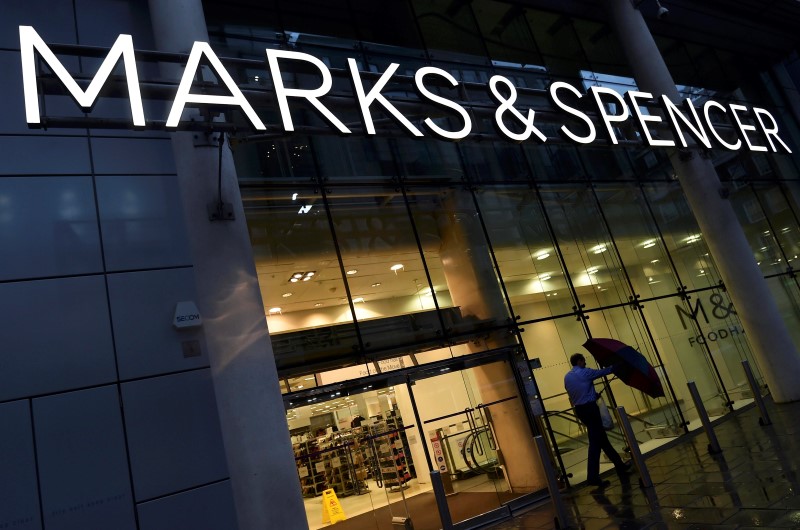By Li-mei Hoang and Kate Holton
LONDON (Reuters) - When Steve Rowe takes over the top job at Marks & Spencer (L:MKS) in April, the 48-year-old soccer-loving Londoner will have to succeed where many others have failed: enticing women to spend on the British institution's fashion.
The 26-year M&S veteran takes charge of a firm struggling to compete in the cut-throat retail sector despite outgoing boss Marc Bolland spending billions modernising the 132-year-old firm's stores, supply chain, logistics and website.
While the building blocks are now in place, Thursday's Christmas trading update accompanying the news of the dapper Dutchman's departure revealed the work that still needs to be done: while food sales outperformed rivals, the performance of women's clothing left a lot to be desired.
"Too much of it is cheap-looking and yucky," said one shopper commenting under the online name Magnolia.
The painful decline of Britain's former retail powerhouse reflects its inability to compete with the fast fashion of the likes of Zara (MC:ITX) and trend setting offerings from Reiss and Whistles.
While M&S is still Britain's biggest clothing retailer by sales, it is engaged in a fierce battle for the middle England pound with high street rival Next (L:NXT) and John Lewis (JLP.UL), Britain's biggest department store chain.
Once the go-to shop for everything from underwear to men's suits and grandma's cardigans, its large, brightly-lit stores have, according to analysts, suffered from its desire to continue being all things to all people.
Aware of its need to serve its most loyal customers - women over 50 - it has failed to attract those younger shoppers who are willing to spend more frequently on fashion.
"It is timid and it is wedded to this kind of 'we have to be cheap, we have to be premium, we have to be all things to all people'" said Neil Saunders from retail consultants Conlumino.
"Of course the result is it ends up being not very much to anybody."
EXPENSIVE
Founded in 1884 on a market stall in northern England, M&S flourished in the second half of the twentieth century, bringing new innovations to the nation such as ladder-resistant stockings and new materials that helped build a reputation for quality.
Asked where she bought her underwear, Margaret Thatcher, prime minister from 1979 to 1990 replied, 'Why, Marks & Spencer of course. Doesn't everyone?'
In 1997 Marks became the first British retailer to post profits of 1 billion pounds but a couple of years later its sales and value nosedived as cheaper and more dynamic brands came to market.
Bolland, with a background in food and drink, spent big on redesigning products, stores, supply chain logistics and the website to compete with more nimble retailers like Zara and H&M (ST:HMb) which offer a more frequent turnover of styles.
In 2012 he brought in Belinda Earl, previously at upmarket store Jaeger, to resuscitate womenswear, with magazines including Vogue lauding items such as a seventies-style suede skirt.
But at the same time Bolland focused on growing the gross margin - the difference between the price M&S pays for goods and the price it sells them - leading to criticism that it was no longer good value for money.
"It's quite expensive now; I noted before Christmas that a jumpsuit that would cost 60-70 pounds at Topshop is 99 pounds at M&S," Pandora Sykes, Fashion Features Editor at the Sunday Times Style magazine, told Reuters.
"In theory that shouldn't matter; Reiss, Whistles, Hobbs and Jaeger would all charge considerably more. But M&S is still primarily a fruit and veg store; they will never totally shed that and their typical customer is an older lady."
M&S's share of Britain's clothing and footwear market has fallen from 13.9 percent in 1997 to 10.3 percent in 2014/15.
According to Interbrand Chief Executive Jez Frampton it started to struggle about 15 years ago.
"It got stuck in a very difficult position which was: Do I target younger consumers who are my future or do I look after my present? And that is a perennial problem," he told Reuters.
In the Christmas trading quarter, like-for-like sales at the general merchandise division fell 5.8 percent which it blamed on unusually warm weather that deterred people from buying winter clothing and poor availability of some items such as coats suited for more milder temperatures.
The drop matched the 5.8 percent fall from the previous year.
The task of righting the clothing ship, particularly womenswear, falls to Rowe, who worked as a Saturday boy at an M&S store in south London at the age of 15.
After a few years at Topshop he returned to M&S for stints in menswear, homeware, beauty, e-commerce and a spell running food. He got the top job in general merchandise last July.
"Steve's done a great job in food, but let's face it he's a rags man," one M&S executive told Reuters late last year.
In one clue to future direction, Rowe recently promoted Queralt Ferrer to overall design responsibility for womenswear - an executive known for a more fashion forward approach.
He may also seek to differentiate collections of clothes offered under names such as Per Una, Limited and Autograph that critics complain are too similar, and he could consider acquiring third-party clothing brands to make a fashion statement.
"We like the fact that Rowe can possibly connect the great heritage of M&S... to the modernised venture," said Clive Black, analyst at Shore Capital.
Rowe is a keen fan of Millwall football club, where fans bask in their own unpopularity by routinely chanting "No one likes us, we don't care."

At M&S, he is popular with staff, colleagues, analysts and media, but has to solve the conundrum of how to bring a once-loved British retailer back into the hearts of today's shoppers.